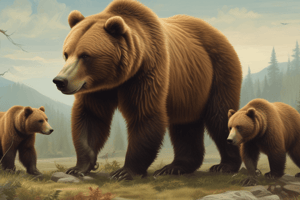Podcast
Questions and Answers
What is the primary role of wildlife in the ecosystem?
What is the primary role of wildlife in the ecosystem?
- To alter habitats and disrupt migration patterns
- To provide ecosystem services and support human well-being (correct)
- To serve as a food source for human populations
- To compete with domesticated animals for resources
What is a major consequence of habitat destruction and fragmentation?
What is a major consequence of habitat destruction and fragmentation?
- Increased biodiversity
- Disruption of migration patterns and species' survival (correct)
- Reduced human-wildlife conflict
- Improved ecosystem health
What is the primary goal of community-based conservation initiatives?
What is the primary goal of community-based conservation initiatives?
- To engage local communities in wildlife management and benefit-sharing (correct)
- To provide a safe habitat for wildlife through protected areas
- To protect endangered species through international agreements
- To research and monitor wildlife behavior and ecosystem health
What is the term for species that have a disproportionate impact on their ecosystems?
What is the term for species that have a disproportionate impact on their ecosystems?
What international agreement regulates trade and protects endangered species?
What international agreement regulates trade and protects endangered species?
What is the term for species that serve as indicators of ecosystem health?
What is the term for species that serve as indicators of ecosystem health?
Study Notes
Wildlife
Definition and Importance
- Wildlife refers to undomesticated animals that live in their natural habitats, including forests, grasslands, deserts, and oceans.
- Wildlife plays a crucial role in maintaining ecological balance, providing ecosystem services, and supporting human well-being.
Threats to Wildlife
- Habitat destruction and fragmentation due to deforestation, urbanization, and infrastructure development.
- Hunting and poaching for bushmeat, trophies, and traditional medicine.
- Climate change altering habitats, disrupting migration patterns, and affecting species' survival.
- Human-wildlife conflict, leading to retaliation against wild animals.
Conservation Efforts
- Protected areas, such as national parks and wildlife reserves, provide a safe habitat for wildlife.
- International agreements, like CITES, regulate trade and protect endangered species.
- Community-based conservation initiatives engage local communities in wildlife management and benefit-sharing.
- Research and monitoring programs help understand wildlife behavior, population dynamics, and ecosystem health.
Key Wildlife Species
- Keystone species: Elephants, wolves, and sea otters, which have a disproportionate impact on their ecosystems.
- Umbrella species: Grizzly bears, mountain lions, and wolves, whose conservation also benefits other species.
- Indicator species: Penguins, corals, and frogs, which serve as indicators of ecosystem health.
Wildlife Management Strategies
- In situ conservation: Protecting wildlife in their natural habitats.
- Ex situ conservation: Breeding and reintroducing species in controlled environments.
- Human-wildlife conflict mitigation: Implementing measures to reduce conflict, such as fencing, corridors, and compensation schemes.
- Education and awareness: Promoting coexistence with wildlife and addressing human behavior.
Wildlife
- Wildlife refers to undomesticated animals that live in their natural habitats, including forests, grasslands, deserts, and oceans.
Importance of Wildlife
- Plays a crucial role in maintaining ecological balance
- Provides ecosystem services, such as pollination, pest control, and nutrient cycling
- Supports human well-being, including physical and mental health, livelihoods, and recreation
Threats to Wildlife
- Habitat destruction and fragmentation due to deforestation, urbanization, and infrastructure development
- Hunting and poaching for bushmeat, trophies, and traditional medicine
- Climate change altering habitats, disrupting migration patterns, and affecting species' survival
- Human-wildlife conflict, leading to retaliation against wild animals
Conservation Efforts
- Protected areas, such as national parks and wildlife reserves, provide a safe habitat for wildlife
- International agreements, like CITES, regulate trade and protect endangered species
- Community-based conservation initiatives engage local communities in wildlife management and benefit-sharing
- Research and monitoring programs help understand wildlife behavior, population dynamics, and ecosystem health
Key Wildlife Species
- Keystone species: Elephants, wolves, and sea otters, which have a disproportionate impact on their ecosystems
- Umbrella species: Grizzly bears, mountain lions, and wolves, whose conservation also benefits other species
- Indicator species: Penguins, corals, and frogs, which serve as indicators of ecosystem health
Wildlife Management Strategies
- In situ conservation: Protecting wildlife in their natural habitats
- Ex situ conservation: Breeding and reintroducing species in controlled environments
- Human-wildlife conflict mitigation: Implementing measures to reduce conflict, such as fencing, corridors, and compensation schemes
- Education and awareness: Promoting coexistence with wildlife and addressing human behavior
Studying That Suits You
Use AI to generate personalized quizzes and flashcards to suit your learning preferences.
Description
This quiz covers the definition and importance of wildlife, as well as the threats they face, including habitat destruction and hunting.




